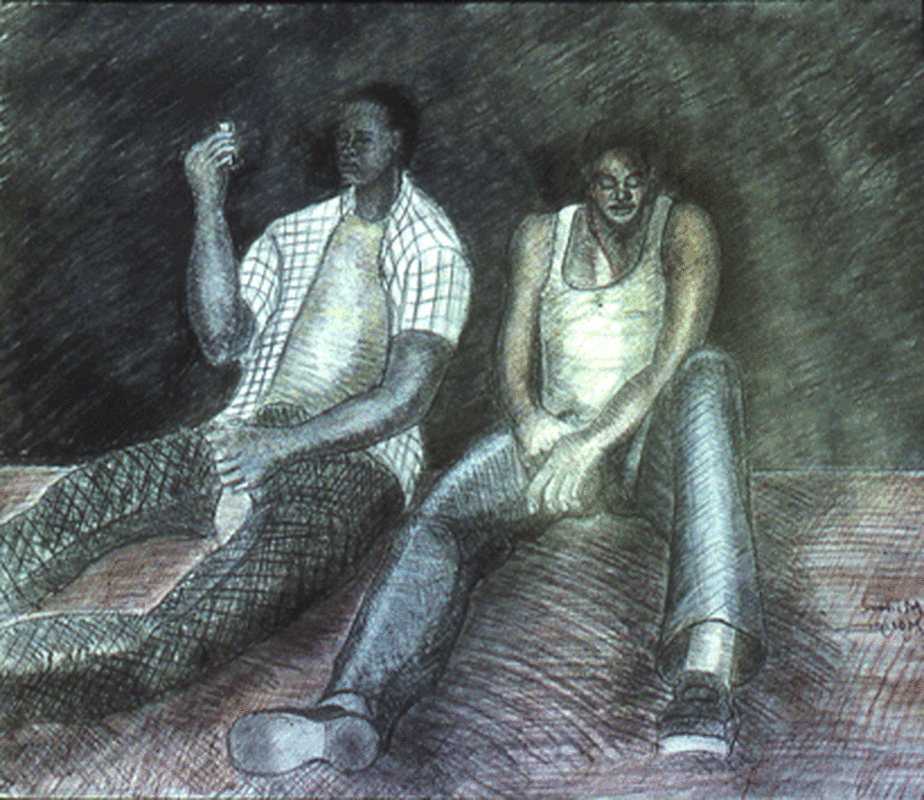Michael C. Morgan
b.1955
from TheBody.com
Michael Morgan has been making art since he was a little boy. He says he always wanted to be an artist, he just had to figure out how. As a young man, he was lucky enough to attend the North Carolina School of Performing Arts in Winston-Salem. In 1976 he moved to Atlanta to study painting at the Atlanta College of Art (now known as the Savannah College of Art and Design). Since then Morgan has won numerous awards for his artworks.
His work is inspired by his life as an HIV-positive black man living in Atlanta. Morgan strives to shed light on the human drama he sees played out every day: "I see so many things ... little kids playing in the yard to drug dealers on my front steps." It's a world that many people never enter, but Morgan wants them to be aware of it. He wants to show the world how "[we're] dealing with substance abuse and AIDS in my neighborhood [because] I deal with some of the brothers from day to day -- I know them personally. They come from all walks of life. Many of them are very intelligent ... and what happened to them could happen to anyone."





The art of Michael Morgan focuses on his perception of the ongoing hypocrisy in the African American and the broader American community in relation to issues of homosexuality, classism, and racism.
From The Georgia Voice Editors, June 11, 2010
"Gay artist tackles homophobia in black community"
Morgan, 54, loved art as a boy growing up in the public school system of Charlotte, N.C. When he became a senior in high school, he wanted more, so he transferred to North Carolina School of Performing Arts in Winston-Salem. In 1976, he moved to Atlanta to study at the Atlanta College of Art, now known as the Savannah College of Art & Design.
The black men Morgan paints and draws are often sad, angry and indifferent. They reflect the young men he says he sees on the streets near his home on North Avenue — often mixed up in drugs and alcoholism as well as having sex with men and women. But these men don’t want to be labeled gay or bisexual, Morgan says. They just don’t care who they have sex with.
Oppression and repression contribute to the malaise of many of Morgan’s characters, who are desperate for understanding and acceptance but feel trapped in a culture where they cannot be who they truly are.
Many of the men Morgan meets on the streets, who have a “thug mentality,” are intelligent and compassionate, he says, but are afraid to show their true character because of the rough environment in which they live.
The black church also makes appearances in Morgan’s “Jack in the Box” series, where a pastor may be preaching damnation to homosexuals but in the background has his own group of young men who are his lovers. The hypocrisy is blatant, Morgan says, and contributes to the confusion many young, gay black men grapple with.
In Morgan’s painting “In the Garden,” a dark figure hovers in the background while another shadowy figure stands to the side. In the foreground are men openly having sex. The shame and guilt of being gay, of wanting to love another man, lurks in the background for many as they seek to express their desires.
“This piece ‘In the Garden’ is dealing with sexuality and shame around sexuality we, I, experienced growing up as a gay male,” he says.
Morgan, who used to live near Piedmont Park, recalls seeing men going in and out of the park seeking sex.
“When you repress a lot of stuff, he [the dark figure] appears. I was thinking in the park, meeting in the park, how some men don’t feel safe, don’t have enough esteem to form a relationship in a so-called ‘normal’ way.”
And while Morgan has been out to friends and family for more than 30 years, he says “coming out” is still an ongoing process in his life.
“I’m still learning about myself as I go on,” he says.
For Sipp, the curator, combining Morgan’s work with Harris’ work was meant to provoke dialogue in the African-American community as well as the community at large about how black people express themselves in today’s society.
The friction in the African-American community about homosexuality — how some black people believe the gay rights movement is superceding the civil rights movement while the progressive black community is accepting — was something Sipp wanted to address.
“In my opinion the gay rights movement is rooted in ancient scripture,” says Sipp, who is straight. “It is much older — it is one of the earliest civil rights movements. And both artists are dealing with racism and sexism. They were both speaking to social taboos and confronting them head on and not burying them under the rug.”
With immigration phobia, homophobia and people believing we live in a post racial country with Barack Obama as president, there is still plenty of discrimination and racism going on that is causing people harm, Sipp says.
“Of all the problems we have in the world the last thing we need to be doing is basically discriminating against people who want to love another. We have so many other problems in the world,” he says.
This article was written in conjunction with:
“Incendiary Exposure: The Works of Daryl Harris & Michael Morgan”
May 2 - June 27
Hammonds House Museum
503 Peeples St. SW, Atlanta, GA 30310
www.hammondshouse.org